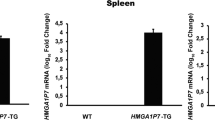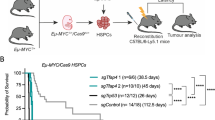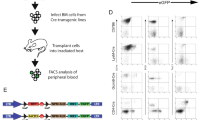Abstract
The c-Myc oncoprotein is strongly implicated in B-cell neoplasms such as human Burkitt lymphomas and mouse plasmocytomas. Transgenic mice in which the myc gene is juxtaposed to an immunoglobulin enhancer (Eμ-myc) also develop B-cell lymphomas, but relatively late in life. In addition, these neoplasms are invariably clonal, suggesting the involvement of additional mutations. Such mutations frequently affect the p53 tumour suppressor gene or its positive regulator Arf, hinting that inactivation of the p53 pathway might be the second hit required for the progression towards malignancy. However, even tumours arising in Eμ-myc/Arf-null animals are thought to be clonal. This observation raised doubts whether overexpression of Myc in p53-null B-cell precursors is sufficient for tumorigenesis. To address this question, we have established a new, non-transgenic mouse model of B-lymphoma. This model is based on isolation of primary bone marrow (BM) cells, admixing them with packaging cells producing a Myc-encoding retrovirus (LMycSN), and subcutaneous injection into a host with which BM cells are syngeneic. Predictably, wild type BM cells infected in vivo by LMycSN were not tumorigenic. However, LMycSN-infected p53-null BM cells readily gave rise to B-cell lymphomas composed predominantly of late pro-B/small pre-B-cells. In these tumours, heavy chain gene rearrangements were analysed using two independent PCR-based assays. All neoplasms with DJ-rearrangements were found to be polyclonal. This result suggests that inactivation of p53 and overexpression of Myc is all that is necessary for the development of full-fledged B-lymphomas. Our model would also be instrumental in assessing the transforming potential of Myc mutants and in studying cooperation between Myc and other oncogenes.
This is a preview of subscription content, access via your institution
Access options
Subscribe to this journal
Receive 50 print issues and online access
$259.00 per year
only $5.18 per issue
Buy this article
- Purchase on Springer Link
- Instant access to full article PDF
Prices may be subject to local taxes which are calculated during checkout



Similar content being viewed by others
References
Adams JM, Harris AW, Pinkert CA, Corcoran LM, Alexander WS, Cory S, Palmiter RD, Brinster RL . 1985 Nature 318: 533–538
Adams JM, Harris AW, Strasser A, Ogilvy S, Cory S . 1999 Oncogene 18: 5268–5277
Baumbach WR, Keath EJ, Cole MD . 1986 J. Virol. 59: 276–283
Blackwood EM, Lugo TG, Kretzner L, King MW, Street AJ, Witte ON, Eisenman RN . 1994 Mol. Biol. Cell 5: 597–609
Bower M . 2001 Br. J. Haemol. 112: 863–873
Brandvold KA, Neiman P, Ruddell A . 2000 Oncogene 19: 2780–2785
Cory S, Vaux DL, Strasser A, Harris AW, Adams JM . 1999 Cancer Res. 59: 1685S–1692S
Dalla-Favera R, Bregni M, Erikson J, Patterson D, Gallo RC, Croce CM . 1982 Proc. Natl. Acad. Sci. USA 79: 7824–7827
Dalla-Favera R, Martinotti S, Gallo RC, Erikson J, Croce CM . 1983 Science 219: 963–967
Eischen CM, Weber JD, Roussel MF, Sherr CJ, Cleveland JL . 1999 Genes Dev. 13: 2658–2669
Eischen CM, Woo D, Roussel MF, Cleveland JL . 2001 Mol. Cell. Biol. 21: 5063–5070
Evan GI, Vousden KH . 2001 Nature 411: 342–348
Fanidi A, Harrington EA, Evan GI . 1992 Nature 359: 554–556
Felsher DW, Zetterberg A, Zhu J, Tlsty T, Bishop JM . 2000 Proc. Natl. Acad. Sci. USA 97: 10544–10548
Hardy RR, Carmack CE, Shinton SA, Kemp JD, Hayakawa K . 1991 J. Exp. Med. 173: 1213–1225
Harris AW, Pinkert CA, Crawford M, Langdon WY, Brinster RL, Adams JM . 1988 J. Exp. Med. 167: 353–371
Hsu B, Marin MC, el-Naggar AK, Stephens LC, Brisbay S, McDonnell TJ . 1995 Oncogene 11: 175–179
Iritani BM, Eisenman RN . 1999 Proc. Natl. Acad. Sci. USA 96: 13180–13185
Jacks T, Remington L, Williams BO, Schmitt EM, Halachmi S, Bronson RT, Weinberg RA . 1994 Curr. Biol. 4: 1–7
Jacobs JJ, Scheijen B, Voncken JW, Kieboom K, Berns A, van Lohuizen M . 1999 Genes Dev. 13: 2678–2690
Klein G . 1993 Gene 135: 189–196
Kovalchuk AL, Qi CF, Torrey TA, Taddesse-Heath L, Feigenbaum L, Park SS, Gerbitz A, Klobeck G, Hoertnagel K, Polack A, Bornkamm GW, Janz S, Morse HC . 2000 J. Exp. Med. 192: 1183–1190
Kulwichit W, Edwards RH, Davenport EM, Baskar JF, Godfrey V, Raab-Traub N . 1998 Proc. Natl. Acad. Sci. USA 95: 11963–11968
Land H, Parada LF, Weinberg RA . 1983 Nature 304: 596–602
Langdon WY, Harris AW, Cory S, Adams JM . 1986 Cell 47: 11–18
Li YS, Hayakawa K, Hardy RR . 1993 J. Exp. Med. 178: 951–960
Lovec H, Grzeschiczek A, Kowalski MB, Moroy T . 1994 EMBO J. 13: 3487–3495
Markowitz D, Goff S, Bank A . 1988 J. Virol. 62: 1120–1124
Newcomb EW . 1995 Leuk. Lymph. 17: 211–221
Ngo C, Gee MS, Akhtar N, Yu D, Volpert OV, Auerbach R, Thomas-Tikhonenko A . 2000 Cell Growth Differ. 11: 201–210
Pear WS, Miller JP, Xu L, Pui JC, Soffer B, Quackenbush RC, Pendergast AM, Bronson R, Aster JC, Scott ML, Baltimore D . 1998 Blood 92: 3780–3792
Pegoraro L, Palumbo A, Erikson J, Falda M, Giovanazzo B, Emanuel BS, Rovera G, Nowell PC, Croce CM . 1984 Proc. Natl. Acad. Sci. USA 81: 7166–7170
Pelengaris S, Littlewood T, Khan M, Elia G, Evan Gl . 1999 Mol. Cell 3: 565–577
Pelicci PG, Knowles DM, Arlin ZA, Wieczorek R, Luciw P, Dina D, Basilico C, Dalla-Favera R . 1986 J. Exp. Med. 164: 2049–2060
Prendergast GC . 1999 Oncogene 18: 2967–2987
Rolink AG, Nutt SL, Melchers F, Busslinger M . 1999 Nature 401: 603–606
Schmidt EV, Pattengale PK, Weir L, Leder P . 1988 Proc. Natl. Acad. Sci. USA 85: 6047–6051
Schmitt CA, McCurrach ME, de Stanchina E, Wallace-Brodeur RR, Lowe SW . 1999 Genes Dev. 13: 2670–2677
Schmitt CA, Rosenthal CT, Lowe SW . 2000 Nature Med. 6: 1029–1035
Serrano M, Lin AW, McCurrach ME, Beach D, Lowe SW . 1997 Cell 88: 593–602
Shen-Ong GL, Keath EJ, Piccoli SP, Cole MD . 1982 Cell 31: 443–452
Sherr CJ, Weber JD . 2000 Curr. Opin. Genet. Dev. 10: 94–99
Strasser A, Harris AW, Bath ML, Cory S . 1990 Nature 348: 331–333
Taub R, Kirsch I, Morton C, Lenoir G, Swan D, Tronick S, Aaronson S, Leder P . 1982 Proc. Natl. Acad. Sci. USA 79: 7837–7841
ten Boekel E, Melchers F, Rolink A . 1995 Int. Immunol. 7: 1013–1019
Wilson JB, Bell JL, Levine AJ . 1996 EMBO J. 15: 3117–3126
Yu D, Thomas-Tikhonenko A . 2001 Cancer Lett. 173: 145–154
Zimber-Strobl U, Strobl L, Hofelmayr H, Kempkes B, Staege MS, Laux G, Christoph B, Polack A, Bornkamm GW . 1999 Curr. Top. Microbiol. Immunol. 246: 315–320
Zindy F, Eischen CM, Randle DH, Kamijo T, Cleveland JL, Sherr CJ, Roussel MF . 1998 Genes Dev. 12: 2424–2433
Acknowledgements
We thank Xin Yin and Gautam Rajpal for their help with performing DJ-recombination assay and Dr Christopher Hunter (University of Pennsylvania) for the gift of several antibodies. We are grateful to Dr Tatyana Golovkina (Jackson Laboratory) for her advice concerning work with p53-null mice. We are indebted to Drs Warren Pear, David Allman and John Monroe (University of Pennsylvania) and Richard Hardy (Fox Chase Cancer Center) for many helpful suggestions during the course of this project. It was supported by the National Cancer Institute grant CA 71881 to A Thomas-Tikhonenko.
Author information
Authors and Affiliations
Corresponding author
Rights and permissions
About this article
Cite this article
Yu, D., Thomas-Tikhonenko, A. A non-transgenic mouse model for B-cell lymphoma: in vivo infection of p53-null bone marrow progenitors by a Myc retrovirus is sufficient for tumorigenesis. Oncogene 21, 1922–1927 (2002). https://doi.org/10.1038/sj.onc.1205244
Received:
Revised:
Accepted:
Published:
Issue Date:
DOI: https://doi.org/10.1038/sj.onc.1205244
Keywords
This article is cited by
-
c-Myc inhibits LAPTM5 expression in B-cell lymphomas
Annals of Hematology (2023)
-
MYC: a multipurpose oncogene with prognostic and therapeutic implications in blood malignancies
Journal of Hematology & Oncology (2021)
-
Transient stabilization, rather than inhibition, of MYC amplifies extrinsic apoptosis and therapeutic responses in refractory B-cell lymphoma
Leukemia (2019)
-
Activating and sustaining c-Myc by depletion of miR-144/451 gene locus contributes to B-lymphomagenesis
Oncogene (2018)
-
A novel rapid-onset high-penetrance plasmacytoma mouse model driven by deregulation of cMYC cooperating with KRAS12V in BALB/c mice
Blood Cancer Journal (2013)



